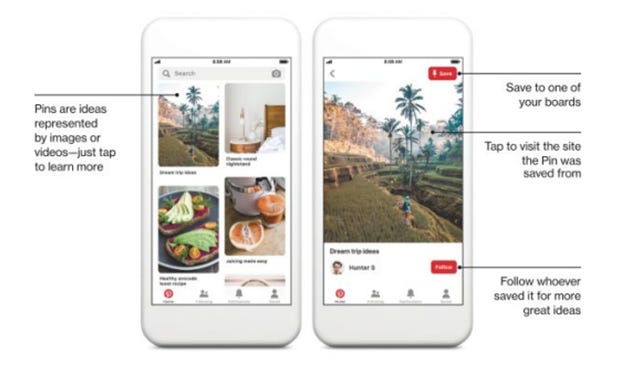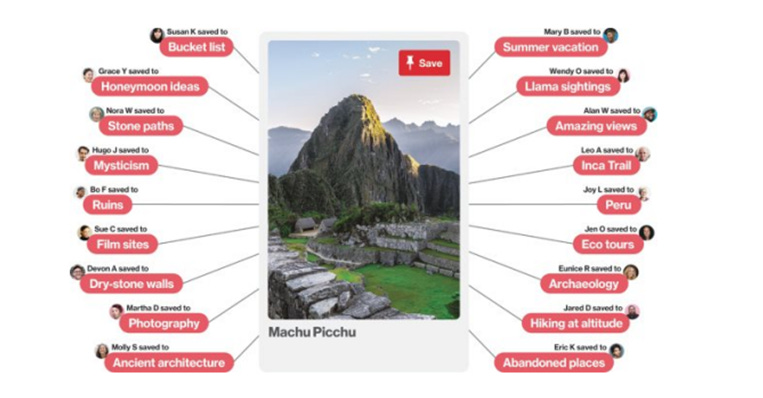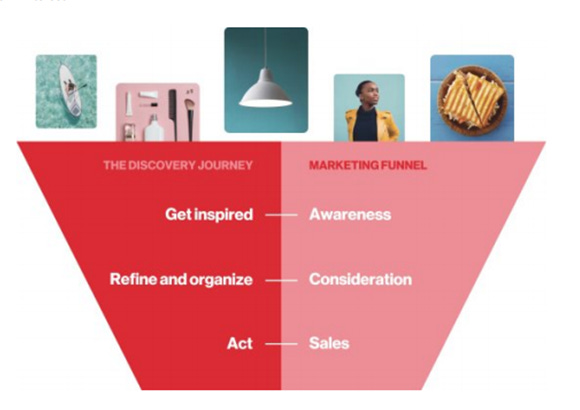Hi Everyone,
Social media has earned a toxic reputation throughout the years. The ecosystems have amplified the addictive qualities of human nature. However, there is one platform that stands out from the rest and is focused to deliver high-value content. Imagine a positive social media network with one of the most powerful visual discovery engines in the market. Today we will breakdown Pinterest (PINS), the company that aims to discover your ideas and turn them into action.
Business Summary:
Pinterest is a social network that gives users the ability to bookmark photos online and create boards with many themes about any personal interest. You can then share your boards with friends and exchange new ideas by following each other. The company classifies itself a media-rich utility platform that gives users the ability to visually discover their ideas and put them into action. During the discovery phase, users, or Pinners, are undecided when it comes to the brands or services that will satisfy their idea or action. Based on a survey by Comscore, Users have stated that they discovered new ideas and inspiration. Additionally, according to Talk Shoppe, users discovered new brands, products, or services. The users seek commercial content creating opportunities for advertisers. The company offers the following products:
Standard Pins: Images that show products/recipes/etc.
Product Pins: Shoppable images that have up-to-date pricing and links to purchase
Collections: Shop for products while viewing general inspiring content
Video Pins: Short videos on how-to content
Technology Features: The technology behind the platform allows for the creation of two types of value propositions:
Value Proposition for Users (Pinners):
Visual Experience: Images and videos help users develop and discover ideas without using words. Ideas can sometimes be difficult to describe and as a result, the company offers visual inspiration at scale. Investment in “computer vision” provides models the ability to see the content of each pin and optimize billions of recommendations.
Human Curation and Personalization: When photos or images are bookmarked or pinned, the ecosystem that is created is handpicked and personalized. It’s important to note here that when people save their pictures/videos they reveal how one contextualizes an idea. Using machine learning and computer vision the company can better predict what users’ needs because users reveal how they organize their ideas.
Designed for Action: 85% of users say they go to Pinterest to start a new project. Each pin has a link to a useful source that outlines products/services/how-to instructions. Up to date pricing and stock information is available and the consumer is taken directly to the checkout page. Users can also use the “Shop to Lock” feature to identify products on sale.
Value Proposition for Advertisers:
Empowering Environment: Users on Pinterest feel inspired and engaged in creative ways. The positive digital experience opens the ability for advertisers to emotionally connect their brands in a creative and positive way as well. Advertisers after all are in the business of inspiration.
Valuable Audience: More people are using Pinterest to purchase products and as a result, Pinterest households were 39% more likely to buy retail products and spent 29% more than the average household. The majority of Pins saved on platforms are from businesses which in result create native content that allowed users and advertisers to exchange naturally.
The company’s mission is to, “bring everyone the inspiration to create a life they love.”
Industry:
The global advertising market is projected to grow to $826 billion in 2022 from $693 billion in 2018. This represents a 5% CAGR, based on the IDC. Digital marketing specifically is experiencing a 12% CAGR which will amount to $423 billion in 2022. CPG and retail accounted for $64 billion of this digital advertising spend and technology, financial services, and entertainment accounted for $144 billion. Ultimately, the United States is the largest digital advertising market accounting for $166 billion in 2022 (~40%).
Market Opportunity:
Pinterest’s total addressable market includes brand advertising and performance-based advertising across many formats.
Online brand advertising: Users on Pinterest have a high intention of buying a product a service. They are undecided as they explore ideas. Majority of the popular searches on Pinterest are unbranded opening an opportunity for advertisers to raise awareness. The potential is projected around $279 billion.
Offline brand advertising: Traditional offline advertising options – specifically print, direct mail, television, and radio – accounted for $378 billion in global advertising spend in 2018. This will eventually transfer to online and Pinterest feels confident they will be the platform to consume this market. This represents a 45% market share.
Online performance advertising: Users on Pinterest browse ideas, and eventually buy products and services. Advertisers want to target the early stage of consumers looking for ideas and as a result, are willing to spend around $169 billion by 2022.
Business Model Landscape:
The company’s revenue is primarily generated by delivering ads on the website and mobile application. Advertisers purchase ads directly with the Pinterest team or relationships with advertising agencies. Based on this model the company recognizes revenue based on user clicks on ads (cost per clicks), views on ads (cost per thousand impressions), and views on video ads (cost per view). The majority of the revenue is generated in the U.S. with expansion opportunities abroad.
The following customer landscape is present for Pinterest:
The company has 442 million monthly active users (343 international MAUs versus 98 US MAUs)
Growth among users under 25
Two-thirds of the total audience is female
8 out of 10 moms were part of the base who are often primary decision-makers when buying products and services
In the U.S. total audience includes 43% internet uses
The average revenue per user in the U.S. is $3.85. The majority of the ads are purchased by CPG and retail companies.
Target, Procter & Gamble, Albertsons, Rothy’s, Pie Provisions, Hubble, and STX Entertainment.
Competitive Strengths (Moats):
The company aims to become a network that delivers positive emotion as consumers discover ideas and purchase products and services to make them a reality. According to SEC filings, Pinterest has the following advantages:
Technology Platform: Pinterest expresses significant value in its database of image-rich pins. This gives the company the ability to generate insights related to trends, understanding consumer intent, and predict consumer behavior. The company aims to invest in resources to realize fine-grained image recognition, object-to-object visual search, and large-scale visual search infrastructure. “An image” is certainly worth 1,000 words to Pinterest.
Network Effects: Pinterest has 442 million monthly active users. Users can search and pin their images and share them between friends and the community at large. The platform creates a positive reaction and a personalized reaction to users. In fact, 82% of users, or Pinners, feel their Pinterest is personalized according to surveys from Talk Shoppe. There is something for everyone to enjoy while using the Platform.
Empowering User: Social media usually permeates a toxic environment. Users, however, view Pinterest as an environment that offers non-judgmental space to explore personal ideas through beautiful high-value content. 91% of users believe Pinterest is filled with positivity.
Advertising Product Suite: The platform allows advertisers to fully tap into the entire sales funnel, from discovery, consideration, and finally the action in terms of sales. The users also come on Pinterest with an intent to realize an idea and execute the value of this alignment between Pinners and advertisers coexist naturally where high-value ads are sought to by users.
Competition/Risks:
The company has highlighted certain competitive and operational risks that may affect its performance.
Competition: The company’s main competitors are Amazon, Facebook (Instagram), Google, and Snap. Additionally, smaller players like Allrecipes, and Houzz, and Tastemade also compete in the same space.
One main revenue stream: The company generates its revenue from advertisers. Monetization of users still has not occurred and that can create significant risks when advertisers have reduced funds. Most advertisers also do not have long term commitments.
Brand Reputation: Because of the many business and products the company does not filter out sites that could be copycats of certain products. These sites are unreliable and sometimes turn out to be scams that could harm the brand reputation that the loyal fan base perceives.
Users authenticate through third-party providers: A large number of users use Facebook or Google login to access Pinterest. While this is a growth strategy it is a double edge sword that can inhibit the platform. Facebook and Google are also competitors with Pinterest. Each operates in its respective space currently, but monetization strategies can create friction.
Team:
The company is led by the original founders and is composed of a team specialized in the content and design space.
Benjamin Silberman: Chairman, CEO, and Co-Founder: Silberman worked in Google before founding the company. He holds a Bachelor of Arts from Yale University.
Evan Sharp: Co-Founder and Chief Design and Creative Officer: Sharp worked on Facebook as a product designer prior to founding Pinterest.
Aya Kanai: Head of Content and Editorial Partnerships: Kanai was previously Marie Claire’s Editor-In-Chief prior to joining Pinterest.
Recent additions to the board of directors are former Disney Executive Salaam Coleman Smith and Former Harpo Studios Executive Andrea Wishom.
Based on new additions to the team and directors the company wants to heavily focus in delivering high quality and inspirational content.
Financial Performance:
The company is trading at $58.38 resulting in a market cap of $36 billion.
The company has achieved $1.1 billion in revenue for the fiscal year ending 12/31/2019, a 51% increase over the $0.8 billion earned in the fiscal year 2018. More recently the company earned $443 million in revenue in Q3 2020, a 58% increase over $280million earned in the same timeframe in 2019. This results in an LTM of $1.3 billion.
Across its 442 million monthly active users the company generates an average revenue per user globally of $1.03 which is 14% YoY.
As of FY 2019 and 2018, the company incurred a net loss of -$1.4 billion and a net loss of -$0.06 billion. The majority of the loss in 2019 was driven by R&D expenses related to the platform. LTM Gross margins are $0.9 billion and ~70.0%.
Pinterest is trading at 24.9x the last twelve months revenue and 16.3x based on an estimate of the next twelve months’ revenue.
Pinterest plans to continue growth through the following strategies:
Utilize computer vision such as “Lens” to improve visual recommendations
Make Pinterest more shoppable
Expand beyond CPG and retail to automotive, technology, financial service, and entertainment
Localizing product and content for global reach
Create high-quality commercial content with brands, retailers, and content creators
-Igli
You can access and download the detailed report here which will include the summary and a company info-graphic. If you like the content please make sure to share this newsletter, share this post, or subscribe (if you have not already)!

















Pinterest Inc. (PINS) Breakdown